The Mango is a fruit that symbolizes the love of our hearts in India and is considered a gesture of friendship. Mango farming is one of the most important commercial crops in India. Mangos are called the king of fruits because they have superb flavor, attractive fragrance, delicious taste, and vitamins A & C. Also, mango trees are hardy and require little maintenance.
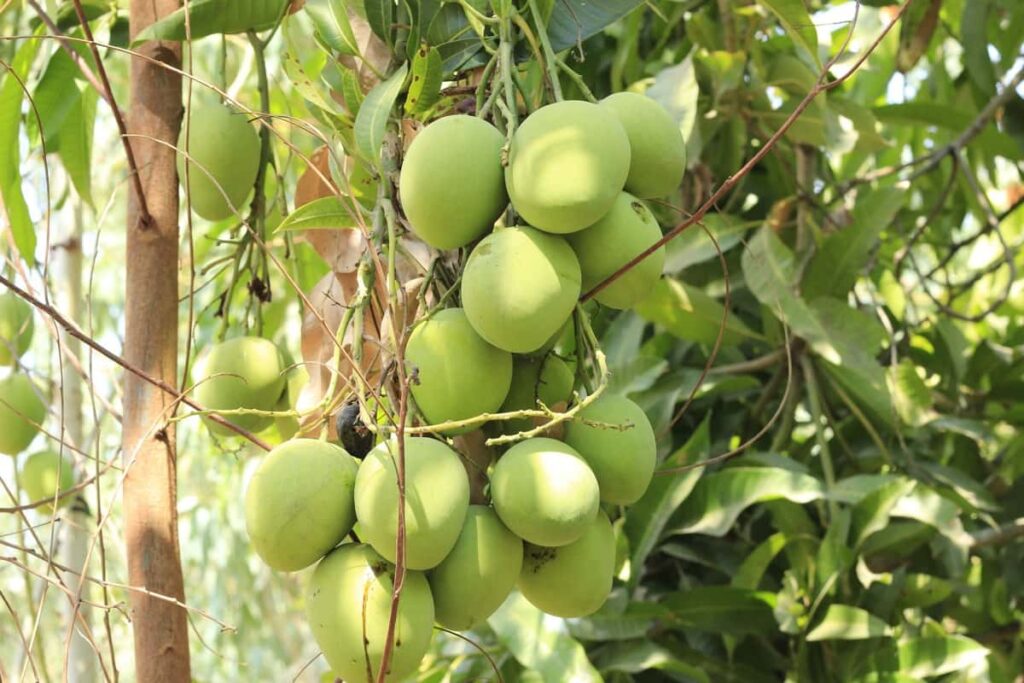
Due to its taste and health benefits, it is one of the most lovable fruits in the world. Mango is a drupe consisting of an external skin, a meaty and pulpy palatable portion, and an organic stone enclosing a seed, similar to a plum, cherry, or peach. India is the world’s largest mango producer, producing more than 20 million tonnes.
India’s major Mango producing states are Andhra Pradesh, Uttar Pradesh, Karnataka, Bihar, Gujarat, and Tamil Nadu. Areas famous for Mango cultivation in Uttarpradesh are Lucknow, Pratapgarh, Allahabad, Bulandshahar, Saharanpur, Faizabad, Varanasi, Moradabad, Barabanki, Meerut, Unnao, Sitapur, Hardoi, Gorakhpur, Basti, JP Nagar, and Mathura are the major Mango producing belts.
Key rules to grow organic Mangoes in Uttarpradesh
How does the Uttarpradesh government support organic farming
The government of Uttar Pradesh promotes Organic Farming under Paramparagat Krishi Vikas Vikas Yojana (PKVY) in 138 Clusters in Chandauli district, one of the 25 Ganga Basin districts under the Namami Gange Project. The activities involve mobilization, registration of farmers, uploading data on the PGS Portal, documentation, training, and capacity building of farmers, providing marketing assistance through arranging linkages with buyers and brand building, etc.
The Uttar Pradesh government has planned to promote organic farming within a 10-kilometer radius of both Ganga river banks throughout the state. The effort has been planned on the river banks in 27 districts through which Ganga flows, including Bijnor, Badaun, Amroha, Meerut, Bulandshahr, Aligarh, Farrukhabad, Kannauj, Kanpur city, Kanpur Dehat, Fatehpur, Prayagraj, Mirzapur, and Ghazipur.
Mango varieties widely cultivated in Uttarpradesh
With an average annual production of 45,00,000 tons of mangoes in Uttar Pradesh, popular varieties such as Chausa, Dusheri, Fazli, Gulab Khas, Langra’, Mallika, and Amrapali are produced in the state.
Dasheri Mangoes – Lucknow and Malihabad, Uttar Pradesh
Known as royal mangoes, dasheri mangoes hail from Lucknow, the land of Nawabs. In North India, this town is known for its mango chain. From May through August, they are available. Due to their wholesome taste, dasheri mangoes grow easily in different varieties in India.
In case you missed it: Dashehari Mango Farming in India: Cultivation and Production Practices
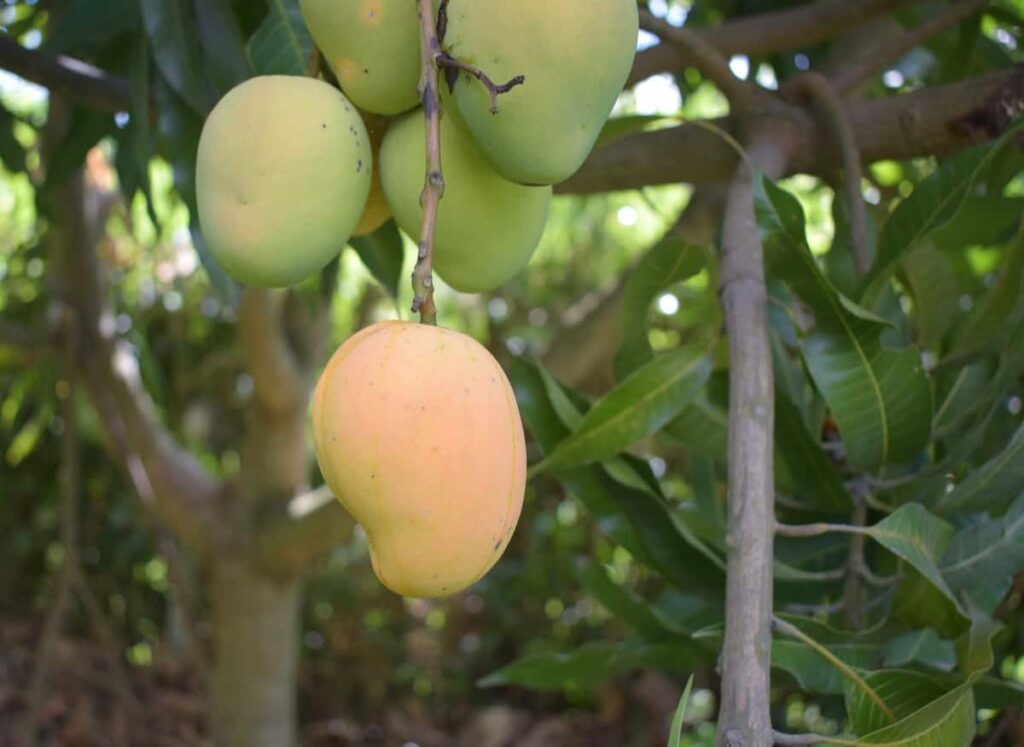
Langra Mangoes – Varanasi, Uttar Pradesh
Langra Mango is famous for its medium-sized mangoes. Natives of these mangoes easily narrate a farmer who cultivated this type of Mango. Known for their lemon-yellow skin and delicious taste, Banarasi Langra mangoes are available from June to July. Approximately 3 tons of Langra mangoes are produced per acre on average.
Chausa Mangoes – Hardoi, Uttar Pradesh
Chaunsa Mango trees are, for the most part enduring evergreen trees that may accomplish a stature of 50 ft and additionally expansiveness of 30 feet. The Mango’s skin is calfskin-like and varies in shading from yellow-hued green to red. The mango seed can be found amidst the natural product. The foliage is golden, pink, or even light green-hued and transforms into dull green at development. This variety would yield around 2.5 to 3 tonnes of fruits per year.
Fazli mangoes – Malihabad, Uttarpradesh
Fazli mangoes are known for their size. These green-colored mangoes are also grown in Bengal and other states, but the premium quality Fazli mangoes come from UP’s Malihabad, Lucknow, and Saharanpur. Its pulp is fibreless and a late maturing mango that ripes in August. Because of its fibreless pulp, it is also a common ingredient for jams and pickles. The aroma of this Mango is very good, and the taste is very sweet. These mangoes are huge, weighing 1-1.5 kg each.
Climate and soil for Mango cultivation organically
As long as there are no frosts, high humidity, or rains during flowering, mangoes thrive up to 600 meters above mean sea level. Temperatures between 24°C and 27°C are ideal. Temperatures as high as 48°C can be tolerated as long as trees are regularly irrigated. It has been found that mangoes can grow on various soil types. The best soils for cultivation are deep and well-drained loams or sandy loams. Heavy black cotton, saline, and alkaline soil should be avoided. A pH range of 5.5 to 7.5 is ideal for mango cultivation.
Raising seedlings for organic Mango cultivation
Grafting uses rootstock grown from seedling mango trees. As soon as the stones are removed from the ripe fruit, they are sown because they are no longer viable. The stones should be immersed in water before sowing, and only those stones that sink should be sown. Stones are sown in well-prepared beds in July and August.
In case you missed it: How to Control Pests and Diseases in Mango: Causes, Symptoms, Chemical, and Biological Management
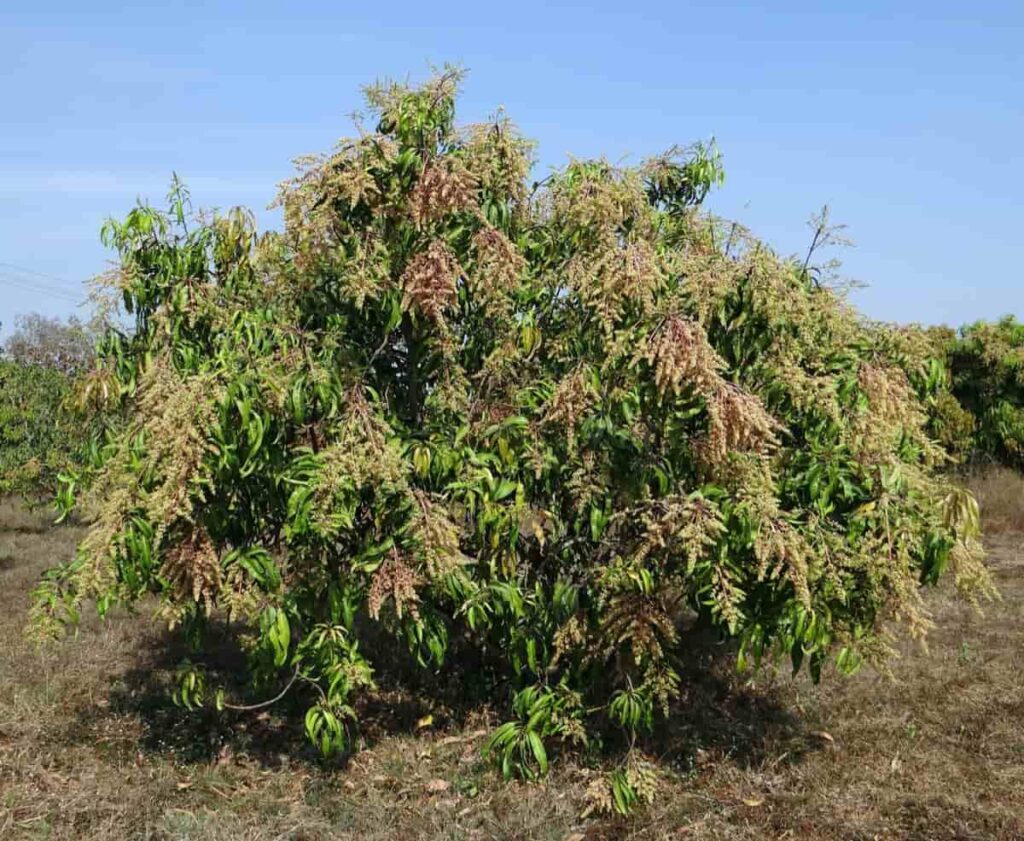
After every two rows, 60 cm is left between the seedlings to allow for cultural practices and grafting. Seeds are planted 45 cm apart in the beds. After the stones have been sown, a layer of sand and farmyard manure is applied. In July-August, seedlings become graftable, but some well-cared seeds are ready for grafting even in March-April.
Land preparation and planting of Mango trees in the main field
A gentle slope is recommended for good drainage, followed by deep plowing and harrowing the ground. In dry areas where growth is less, spacing is 10 m x 10 m, and in heavy rainfall areas and rich soils, 12 m x 12 m. In rich soils and dry areas with abundant growth, spacing is 12 m x 12 m.
In new dwarf hybrids like Amrapali, planting spacing can be reduced to 5m x 5m. A mixture of the original soil and well-rotten farmyard manure is used to fill pits. The earth ball should remain intact during planting, and the graft union should be above ground. When selecting plant materials, keep the following points in mind:
- The plants should be purchased from reputable nurseries.
- Approximately 25 cm above ground level should be the height of the graft union.
- Insect pests/diseases should be controlled, and the plants should grow vigorously.
- It is best to remove the plant with an earth ball of a good size to preserve as much of the root system as possible.
- The plant must be handled carefully during transit for the graft union and earth ball to remain sound.
Aftercare of young Mango plants
- Young fruit plants should be irrigated after planting. It is important to avoid heavy watering and stagnant water in their basins.
- When stock sprouts appear, remove/pinch them off.
- Remove any tying material from the bud/graft union to prevent constriction.
- Assist the plants in growing upright by supporting them.
Irrigation requirement in Mango cultivation
The mango tree is considered drought resistant to some extent; however, soil moisture influences the fruit size, quality, and drop of immature fruits. Under hot and dry climates, irrigation prevents the drop of immature fruits during fruit development. It is also observed that soil moisture deficit results in the early maturity of fruits and poor quality.
Properly irrigated trees have fruits of better size and juicier than those with soil moisture deficit. Mango orchards are usually irrigated by conventional methods such as flood, basin, ring, and furrow. There are five stages of the Mango tree life cycle: flowering, fruit development, vegetative growth, root development, and dormancy.
Trees require about 80 percent of water during flowering and fruit development stages. Therefore, stopping irrigation at least 10 to 15 days before harvest is advisable. Depending on soil type, climatic conditions, plant density, variety, size, and age of trees, the annual water requirements vary from 50 to 400 liters/day/plant.
In case you missed it: High Yield Hybrid Mango Varieties in India: State Wise Growing Guide
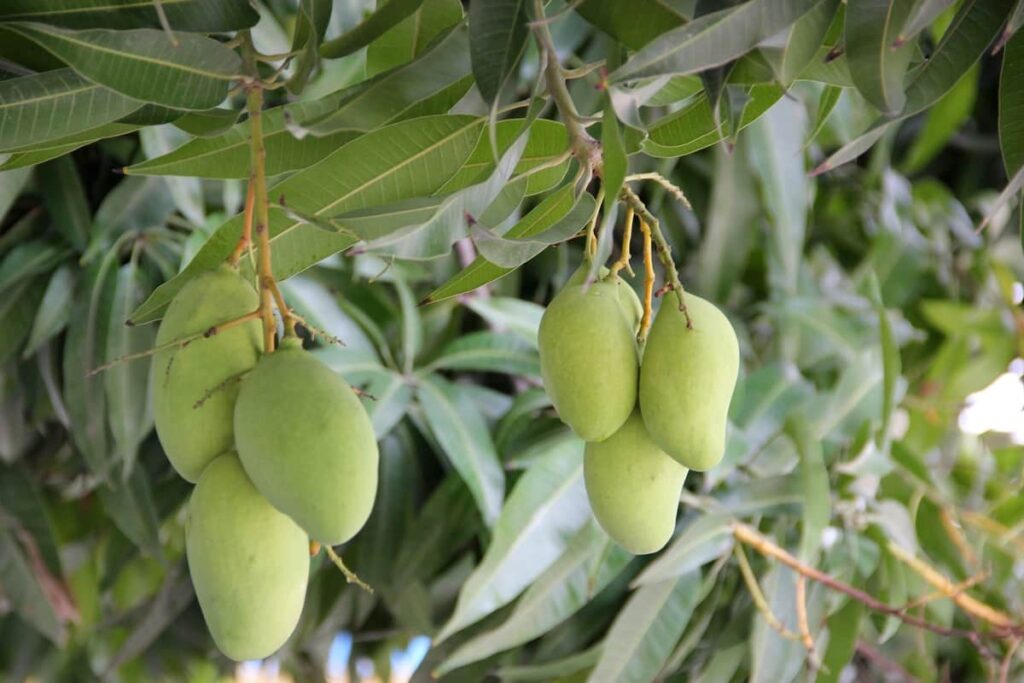
Manure application in organic Mango farming
When mango trees are young, they require more nitrogen, but once they bear fruit, they need less. Therefore, the phosphorus and potassium they need at that time are higher, thus promoting flowering and fruiting. In addition to phosphorus, compost is a good source of potassium. As a source of phosphorus, rock phosphate, guano, blood meal, and bone meal can also be used, while seaweed or potassium sulfate can provide potassium.
Micronutrients such as calcium, magnesium, zinc, copper, and boron are essential for mango trees. As soil microorganisms break down compost and manure, they provide a balanced range of micronutrients, so mulching twice a year is the easiest way to apply them. Acidic soil allows trees to absorb nutrients easily, but alkaline soil requires foliar spraying nutrients. As an organic source of micronutrients and potassium, liquid kelp is mixed with water and applied by drenching or spraying.
Protection from frost and hot weather
Protect the young plants from frost and low-temperature injury for at least three to four years by covering them with suitable thatching material. It is also possible to ward off the ill effects of frost by irrigation. Plants/trees can also be protected against hot weather by whitewashing their lower basal portion. Plant trunks can also be wrapped with old gunny bags, or young plants can be given thatches.
Training and pruning
During the early years of the tree’s life, training is essential to ensure that the branches are evenly spaced. In addition, it is recommended that the main branches grow in different directions at least 30 cm apart and have good crotch angles. Since mango trees bear terminally, only overcrowded, diseased, and dead branches must be pruned yearly.
Pests in Mango cultivation and organic control
Mango hopper
Damage symptoms
- Nymphs and adult insects puncture and suck the sap of tender parts, reducing the vigor of plants.
- Heavy puncturing and continuous sap draining cause curling and drying of infested tissue.
- They also damage the crop by excreting a sweet sticky substance that facilitates the development of sooty mold.
Control
- There is biological control through predators such as Mallada boninensis and Chrysopa lacciperda and egg parasites such as Polynema sp.
- A fungus called Metarhizium anisopliae or Beauveria bassiana may also be used to treat mango trees affected by this disease.
- Neem oil sprays (3%) can also significantly reduce hopper populations.
Mango mealybug
Damage symptoms
- The adult bugs are covered with whitish powder and colonize between the bark of tree trunks, young shoots, and panicles
- The nymphs ascend the trees and settle on inflorescence causing flower drop and affecting fruit set.
- They also excrete honeydew, a sticky substance, which facilitates the development of sooty mold.
In case you missed it: Growing Banana Organically in Maharashtra: Cultivation Practices and Production Management
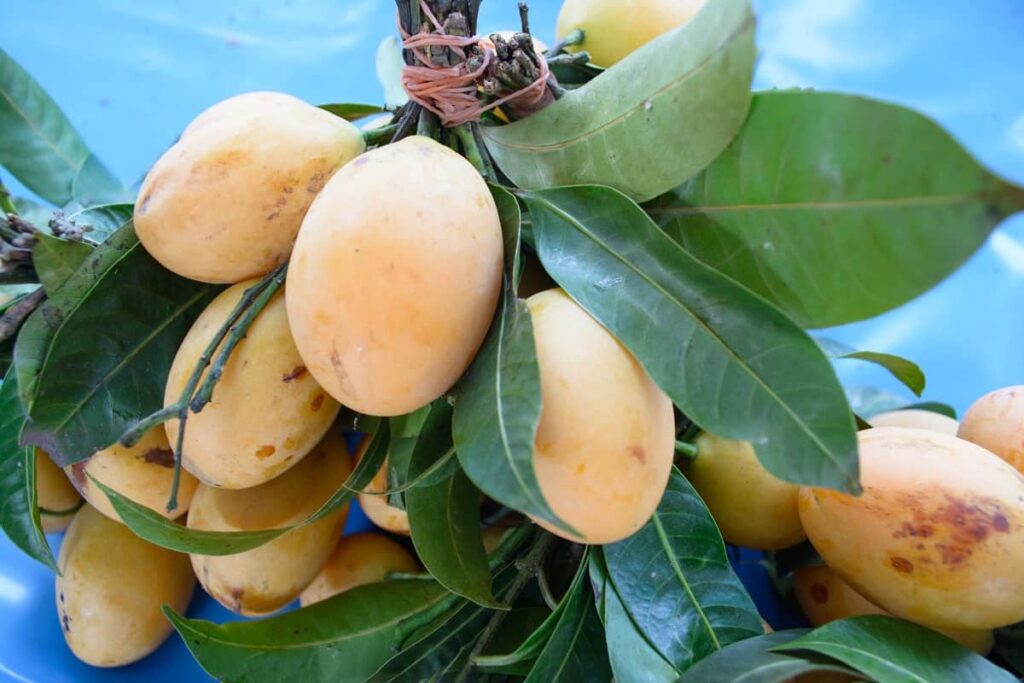
Control
- Neem oil is a natural insecticide and repellent that disrupts pest insect growth and development.
- Mealybug destroyers, such as Cryptolaemus montrouzieri, feed voraciously on mealybugs in all stages of their development.
- Mealybugs are susceptible to insect soap sprays because of their soft bodies. To kill insects, sprays must be applied directly to their cell membranes.
Mango nut weevil
Damage symptoms
- Grub makes zigzag tunnels in pulp
- Eats unripe tissue and bores into cotyledons
- Fruit dropping at marble stage
- Oviposition injuries on marble-sized fruits.
Control
- Collect and destroy infested and fallen fruits at weekly intervals till fruit harvest.
- Plowing the orchard after harvest exposes hibernating adults and reduces infestation levels.
- Destroy all leftover seeds in the orchard and also in the processing industries.
Mango diseases and their organic control
Phoma blight
Disease symptom
- At first, lesions are yellow to light brown, angular, and irregularly shaped.
- A brownish color changes to a cinnamon color as the lesions enlarge.
- Spots with a fully developed margin have dark necrotic centers and a dull gray margin.
Control
- Spraying copper oxychloride (0.3%) just after the appearance of the first symptoms, followed by subsequent sprays every 20 days, may control the disease.
- In combination with cool storage, neem leaf extracts completely inhibit the growth of pathogens on fruits.
Anthracnose
Disease symptoms
- The disease severely damages young shoots, flowers, and fruits.
- Leaf spot, blossom blight, twig blight, wither tip, and fruit rot are symptoms of this disease.
- The young fruit that has been infected develops black spots, withers, and dies.
Control
- Hot water treatment at 520C for 4-5min.
- Prune trees yearly and remove fallen plant debris from the ground.
- Use resistant plant varieties.
In case you missed it: How to Fertilize Avocado Trees For Insane Fruit Set: Schedule for Natural, Organic, and Chemical Application
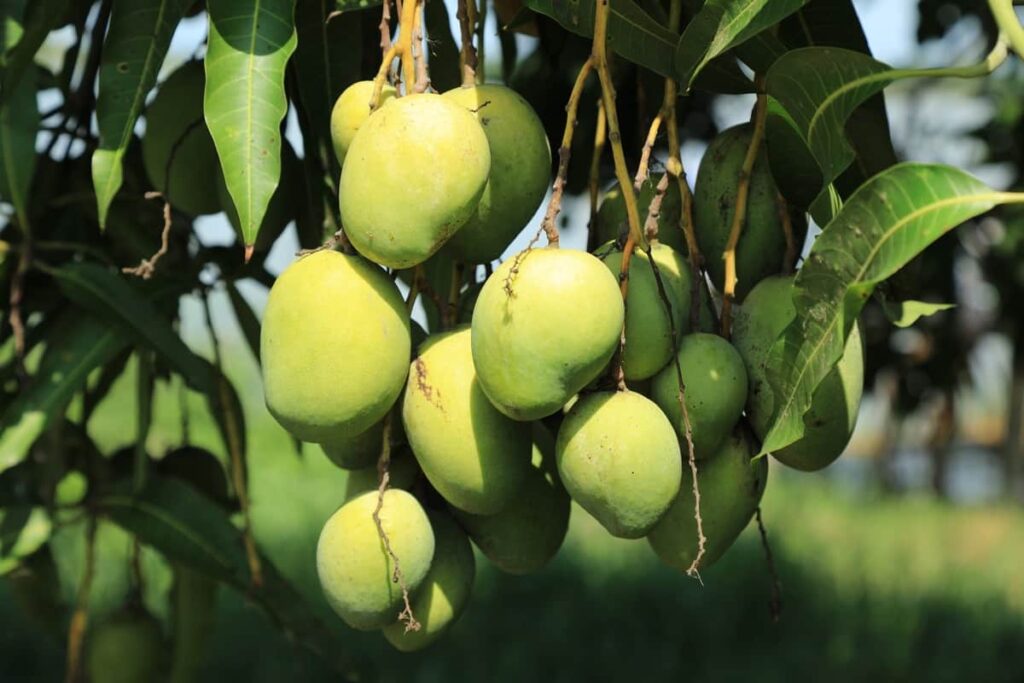
Powdery mildew
Disease symptoms
- White powdery growth is the characteristic symptom of the disease on leaves, panicle stalks, flowers, and young fruits.
- The fake flowers and fruits drop prematurely, reducing the crop load significantly or even preventing fruit set altogether.
- The fungus parasitizes young tissues throughout the inflorescence, leaves, and fruits.
Control
- Spraying with bio-fungicides containing Bacillus licheniformis reduces powdery mildew infections.
- Treating plants with foliar sprays based on sulfur, carbonic acid, and neem oil can prevent severe infection.
Harvesting Mango crop
The maturity of a mango fruit takes 120 to 140 days from the moment it is set. Mango fruits mature with raised shoulders (sides) and sunken attachments to the stalk. At maturity, the dark green fruits turn pale green to yellowish. At maturity, some mango varieties form a clear white layer on their skin. Varieties, climate conditions, plant population, and other factors affect the yield of fruits.
Mango harvesting tips
- Do not keep the freshly harvested fruits under direct sunlight.
- Harvest the mango fruit with its stalk attached; otherwise, the sticky mucilage will ooze out of the fruit forming black spots near the stalk end.
- All the fruits on the same tree may not mature simultaneously. Therefore it is recommended to do 2-3 rounds of harvesting in an orchard weekly.
- While harvesting, do not let the fruits fall on the ground. Use specialized mango harvesters with blade and nylon nets to efficiently harvest and collect fruits.
Conclusion
In India and abroad, organic mangoes are becoming increasingly popular. Even though the yield is moderate, with the right techniques, costs can be reduced, and profits can be increased. In high-density mango farming, 100 saplings of mango trees are planted on an acre rather than 40 saplings in traditional farming. Compared to traditional farming techniques that require little to no maintenance, high-density farming can produce 9-10 tonnes per acre.
- Profitable Village Farming Business Ideas in 2024
- High-Yield Aquaculture: Fast-Growing Fish for Farming
- Effective Fish Pond Construction Techniques for Beginners
- Irrigation and Water Management in Pineapple Farming
- Blossom to Harvest: Mastering Flowering and Pollination in Papaya Farming
- Pig Fattening Essentials: From Selection to Sale for Beginners
- Raising Wagyu Cattle: A Complete Guide for Premium Beef Production
- Soil Types and Their Water Holding Capacity
- Optimizing Irrigation Schedules for Coconut Groves for Enhanced Yield
- Espresso Your Garden: Coffee Grounds for Healthier Acid-Loving Plants
- The Best Soil Mix for Snake Plants: How to Mix Your Own Snake Plant Soil
- Green Thumb Success: Expert Tips for Cultivating Greenhouse Beans All Year Round
- Bloom All Year Round: The Ultimate Guide to Indoor Hyacinth Care
- Eco-Friendly Gardening: How to Make Liquid Fertilizer from Kitchen Waste
- Ultimate Guide to Grow Anise in Pots: Explore Seed Propagation to Harvesting
- Guide to Raising Chester White Pigs: Discover Breed Facts to Growth Management
- Mastering the Elegance: The Ultimate Guide to Weeping Cherry Tree Care, Planting, and Maintenance
- Ultimate Guide to Planting Garlic in Grow Bags: Growing Strategies for Beginners
- How to Fix Spider Plant Leaf-Related Problems: Natural and Organic Remedies
- 10 Reasons Why Your Tulsi Plant is Shedding Leaves: Home Remedies and Solutions
- Optimizing Growth and Yield: The Advantages of Palm Bunch Ash Fertilizer
- Utilizing Neem Oil Extract as a Natural Pesticide for Hydrangea
- From Soil to Harvest: Various Ways in Which Farmers Can Use AI Tools
- Steps to Encourage and Induce Citrus Flowers: A Comprehensive Guide
- How to Fix Snake Plant Leaf-Related Issues: Natural and Organic Remedies
- Transform Your Garden into a Fragrant Oasis with Raat Ki Rani (Night Blooming Jasmine)
- Discover the Ideal Chicken Breeds for Philippine Farms
- How to Create a Poultry Egg Farm Business Plan for Profits
- Grow Lemon Cucumbers Like a Pro: Insider Techniques for Bountiful Yields
- Ultimate Guide to Caring for Your Pink Princess Philodendron: Tips for Thriving Variegation
- Areca Nut Profit Per Acre: Calculating Yield and Cost of Cultivation
- How Kaveri Chicken is Becoming a More Profitable Breed in Indian Backyards
- Transform Your Barn: 9 Steps to Convert a Horse Stall into a Chicken Coop
- Exploring Suffolk Sheep Disadvantages with Limitations and Challenges
- Guide to Solving Potted Lemon Tree Problems: How to Revive Lemon Tree in Containers
- Steps to Encourage Female Pumpkin Flowers: Best Strategies for More Flowers and High Yields
